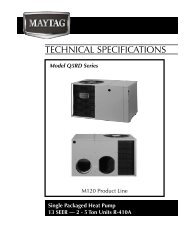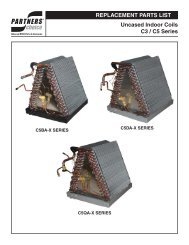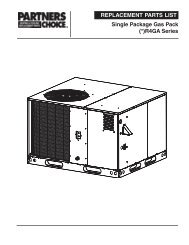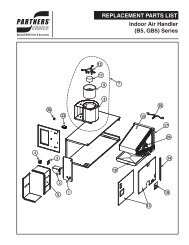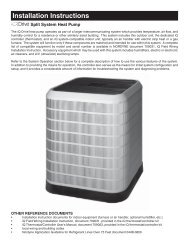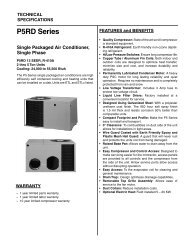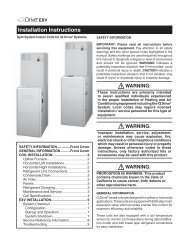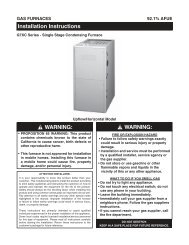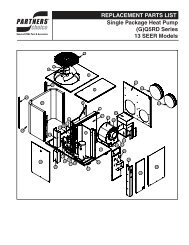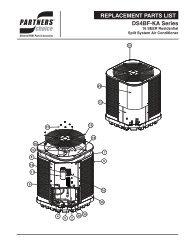warning - Nordyne
warning - Nordyne
warning - Nordyne
You also want an ePaper? Increase the reach of your titles
YUMPU automatically turns print PDFs into web optimized ePapers that Google loves.
WARNING:Ensure that the combustion air ventand the exhaust vent are configured asshown in Figure 19 and 20. Impropervent termination can cause recirculationof the flue gases. This mayresult in furnace vibration. In severecases, the furnace will cycle due tothe intermittent contact between theflame and the flame sensor. If younote oscillations occurring, check thevent configuration. Make sure thatthe exhaust vent does not have a 90degree termination.Vent and combustion air intake terminations mustbe located to ensure proper furnace operationand to conform to applicable codes. Figure 19and 20 illustrates necessary distances from thevent termination to windows and building air intakes.In Canada, the Canadian Fuel Gas Codetakes precedence over these instructions.Specifically, all minimum distance requirementswith respect to termination of the ventpiping listed below (items 1 through 8).The following list is a summary of vent terminallocation requirements:1. The termination must be 12 inches abovesnow level or grade level whichever ishigher. See Figure 18 for alternate methodto achieve 12” above snow level.2. The minimum distance for a (1-pipe installation)from any door, (openable) window, orgravity air inlet is 4 ft. below, 4 ft. horizontally,or 1 ft. above.3. The minimum distance for a direct vent (2-pipe) installation from any door, (openable)window, or air gravity inlet is 1 ft. below, 1ft. horizontally, or 1 ft. above.4. For one-pipe installations the recommendedminimum distance from an inside cornerformed by two exterior walls is 6 feet, butis not required.5. The vent termination for a 1-pipe installationshall be a minimum of 3 ft. above any forcedair inlet within 10 ft.6. The vent termination shall be located at least3 ft. horizontally from any electric meter, gasmeter, regulator and any relief equipmentin accordance to ANSI 2223.1/NFPA S4.These distances apply ONLY to U.S. installations.In Canada, the Canadian Fuel GasCode takes precedence.7. Avoid areas where condensate drainagemay cause problems by dropping on plantersor patios, etc. Also ensure that exhaustgases will not impinge on windows or buildingsurfaces, which may be compromised ordamaged by condensation. Do not install thevent terminal such that exhaust is directedinto window wells, stairwells, under decksor into alcoves or similar recessed areas,and do not terminate above any publicwalkways.8. Select the point of wall penetration wherethe minimum 1/4 inch per foot of slope upcan be maintained.CAUTION:For optimum performance, vent furnacethrough wall which experiencesthe least exposure to winter winds.For Canadian installations please refer to theCanadian Installation Code (CAN/CGA-B149.1or 2) and/or local codes.The horizontal venting kits consist of two faceplates and an insulating gasket to seal the exteriorsurface. A hole sized closely to the pipe diametermust fi rst be cut through the wall. A short lengthof pipe is then cut such that it can penetratethe wall and be held in place by closely fi ttingstandard couplings. The face plates are retainedon both sides of the wall by the couplings, andthe gasket is retained against the wall by theouter face plate. Face plates must be fastenedto the wall and the outside one must be fl ashedas appropriate to prevent entry of water.When the horizontal kits are not used, the followingsteps are required:1. Check the hole size cut through the exteriorwall. Insure that the hole diameter is lessthan the diameter of the couplings to beused.2. Extend the vent pipe through the wall approximately1” and seal the area betweenthe wall and pipe.3. If required by local code, apply couplingsto the vent pipe on the interior and exteriorsides of the wall to insure the pipe can notbe pushed or pulled through the wall.22



